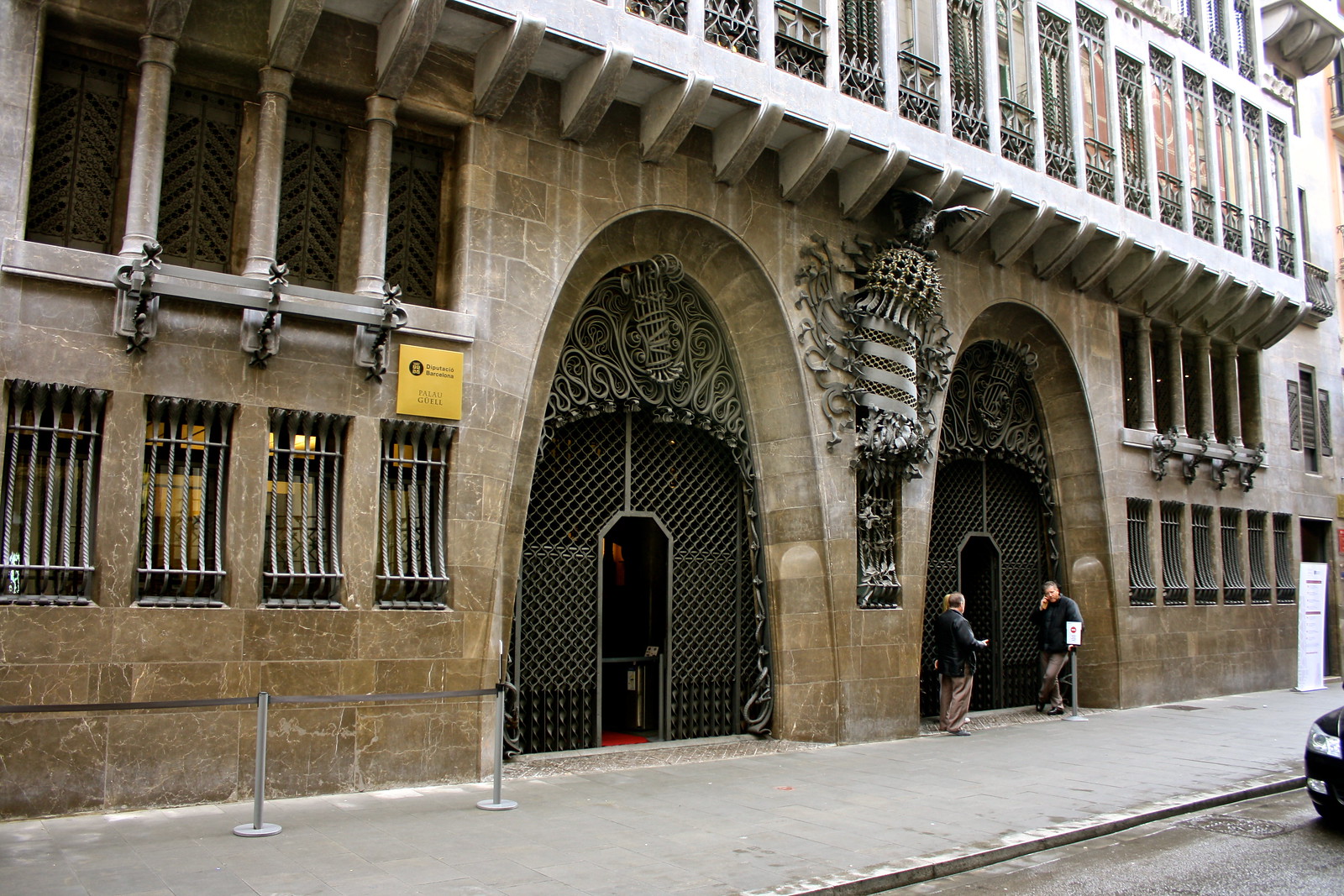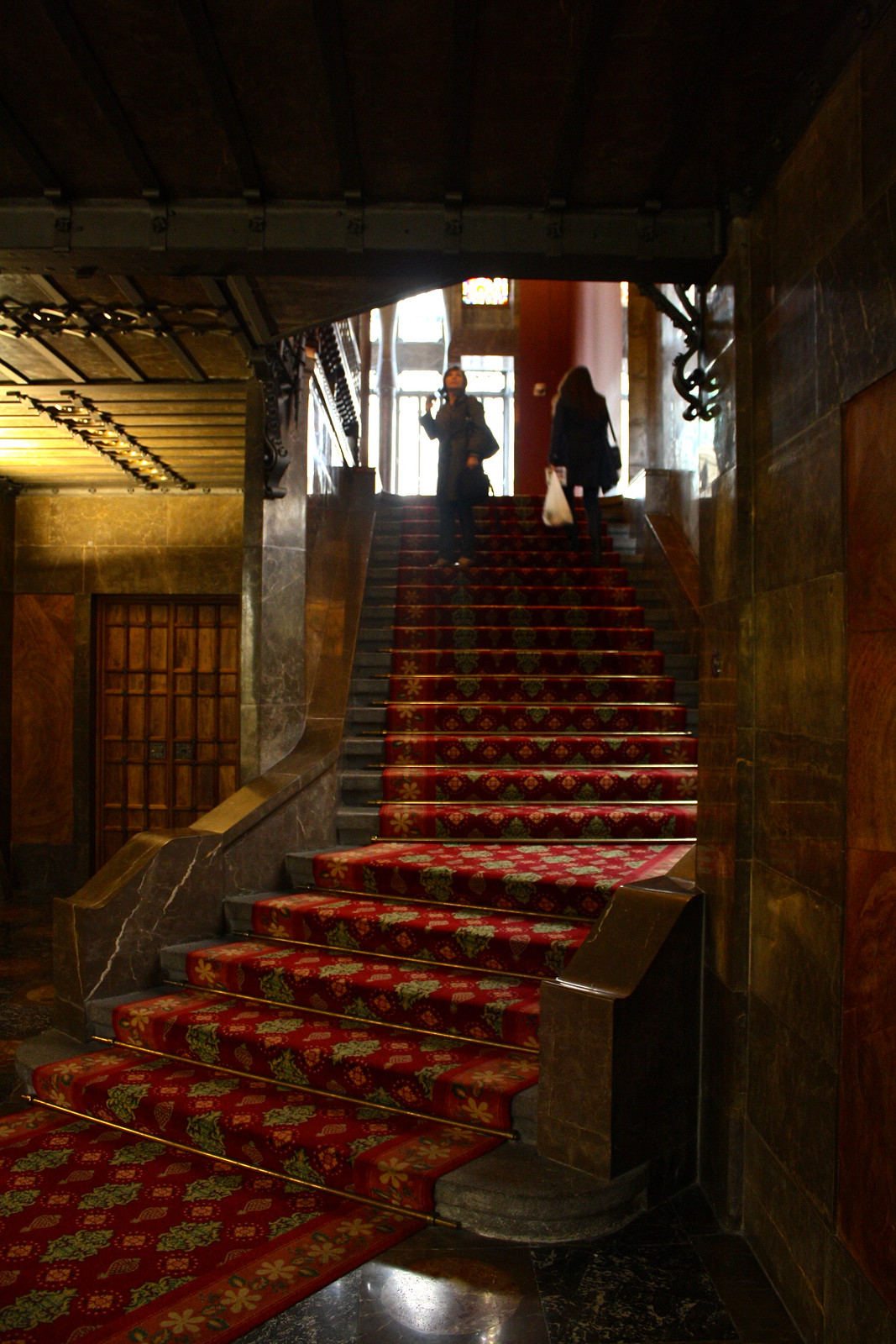Gaudí Week #5: Palau Güell in Barcelona, Spain
This week on the blog, I’m celebrating works by the famous turn-of-the-century Catalan architect Antoni Gaudí, who designed everything from churches to mansions to public parks. This is the fifth post in a seven-part series; check out the introduction here!
The only work by Antoni Gaudí in Barcelona’s old city, Palau Güell (“Güell Mansion”) fits in with the medieval feel of the neighborhood and reflects the architect’s budding creativity. Owned by the same Eusebi Güell as #3 (the park) and #6 (the church) in this blog series, the mansion was Gaudí’s first commission for the textile magnate. Although the Catalan word palau is best translated as “mansion,” its cognate, “palace,” could just as easily be used to describe this palatial home.
Residents and guests would enter from the street under one of two eye-like parabolic arches decorated in intricate ironwork. Once inside, their horses and carriages would be led down to an underground stable, which, despite its lowly function, reflects the elegant arches and vaulting Gaudí would later use in the Sagrada Família.
The living quarters are cozy but not gloomy, warm but not gaudy, made of stone but not cold, and solid without being cave-like. The smooth, finished stone from the exterior continues inside—a simple, sophisticated skeleton that was fleshed out with rugs, lamps, and furniture. The whole house centers around the main living area that was used for welcoming guests. This space was used both for entertaining and for prayer; a brilliant, gilded chapel is balanced by a powerful organ whose notes fill the dome-capped hall.
Although Palau Güell isn’t as obviously Gaudí as his later works, you can still see his nascent style coming to life: he flirted with Moorish elements by installing a golden ceiling and bathroom tiles that look more at home at Sevilla’s Royal Alcázar than a Barcelona palace; he put slender, yawning parabolas everywhere, from windows to arches; and he incorporated natural elements by forging vines, seed hulls, and even a phoenix out of iron.
As with Casa Batlló and La Pedrera, Palau Güell also has a surprise on its roof. Although the chimneys are evenly distributed around the perimeter, they’re just as whimsical and fun as those on his other two works in the new part of town. Decorated with tightly-arranged trencadís mosaics, the chimneys look like anything from rainbow frozen yogurt and bulbous Christmas trees to zebra skin and goblin faces. If you look hard enough to the east, you can catch glimpses of the octagonal belltowers on the Catalan churches of Santa Maria del Mar and Santa Maria del Pi in the distance.
If you’ve ever been to Barcelona’s Barri Gòtic before, did you get a chance to visit Palau Güell? Comment below!
 |
| Palau Güell from the street |
The only work by Antoni Gaudí in Barcelona’s old city, Palau Güell (“Güell Mansion”) fits in with the medieval feel of the neighborhood and reflects the architect’s budding creativity. Owned by the same Eusebi Güell as #3 (the park) and #6 (the church) in this blog series, the mansion was Gaudí’s first commission for the textile magnate. Although the Catalan word palau is best translated as “mansion,” its cognate, “palace,” could just as easily be used to describe this palatial home.
 |
| Staircase |
Residents and guests would enter from the street under one of two eye-like parabolic arches decorated in intricate ironwork. Once inside, their horses and carriages would be led down to an underground stable, which, despite its lowly function, reflects the elegant arches and vaulting Gaudí would later use in the Sagrada Família.
The living quarters are cozy but not gloomy, warm but not gaudy, made of stone but not cold, and solid without being cave-like. The smooth, finished stone from the exterior continues inside—a simple, sophisticated skeleton that was fleshed out with rugs, lamps, and furniture. The whole house centers around the main living area that was used for welcoming guests. This space was used both for entertaining and for prayer; a brilliant, gilded chapel is balanced by a powerful organ whose notes fill the dome-capped hall.
Although Palau Güell isn’t as obviously Gaudí as his later works, you can still see his nascent style coming to life: he flirted with Moorish elements by installing a golden ceiling and bathroom tiles that look more at home at Sevilla’s Royal Alcázar than a Barcelona palace; he put slender, yawning parabolas everywhere, from windows to arches; and he incorporated natural elements by forging vines, seed hulls, and even a phoenix out of iron.
 |
| Chimney |
As with Casa Batlló and La Pedrera, Palau Güell also has a surprise on its roof. Although the chimneys are evenly distributed around the perimeter, they’re just as whimsical and fun as those on his other two works in the new part of town. Decorated with tightly-arranged trencadís mosaics, the chimneys look like anything from rainbow frozen yogurt and bulbous Christmas trees to zebra skin and goblin faces. If you look hard enough to the east, you can catch glimpses of the octagonal belltowers on the Catalan churches of Santa Maria del Mar and Santa Maria del Pi in the distance.
How to get there
Palau Güell is house Nº 3-5 on C/ Nou de la Rambla in the Ciutat Vella (old town) of Barcelona. If you take the L3 (green line) on the Metro, you can get off at one of two Las Ramblas stops: Liceu to the north and Drassanes to the south. C/ Nou de la Rambla is directly opposite Plaça Reial on the other side of La Rambla dels Caputxins.If you’ve ever been to Barcelona’s Barri Gòtic before, did you get a chance to visit Palau Güell? Comment below!